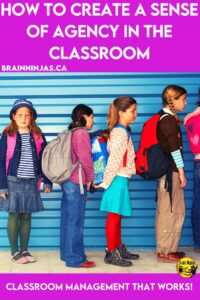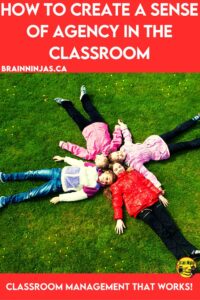
Imagine a classroom where the students monitored themselves-and, not in that “hall pass police officer” type of way. Imagine a classroom where students encouraged each other to keep the room tidy, put things away and treat each other with respect. We call this a sense of agency.
It’s possible because each year we turn out a classroom full of polite and respectful students, but it takes work. Students need to be taught how to make decisions that are positive and what to do when they make a mistake. Creating a sense of agency is just as important as all the math and reading skills. It’s the key to classroom management. Want to know how?
What is a sense of agency?
It is a student-centered approach to classroom management. Students take control of how the classroom runs day to day and by having that control, they take pride in ownership.
By instilling a sense of agency in our students we find we spend very little time dealing with classroom drama. Our students take care of the day to day running of many aspects of our classroom. They manage supplies and seating all the time, but we also ask for their input as much as possible.
While kids are still kids and will mess up from time to time, teaching students to be responsible for themselves is important. One day these kids will be adults and if they don’t learn to make good decisions while they are young, they will struggle as adults.
Here are some ways we create a sense of agency.
We are “we.”
Your choice of word matters. It lets students know from the beginning of every sentence that we are all in this together. By using the word we, you eliminate the us versus them mentality and students won’t feel like it’s you against them or vice versa.
When you talk about your class to others, use the word we and encourage your students to do the same. Start sentences with “In our classroom, we…” It will catch on and your students will feel included.

We Own This Room
Our physical classroom space belongs to all of us. Students help decide what goes on the walls, how the desks are arranged, how we hand out materials and where we sit. (Disclaimer-this takes time and not all of it happens on the first day).
On the first day, the desks are laid out however we feel is good and we ask students to pick a seat. We talk about what we need to learn-our own space, quiet/not too quiet, room to work or write, special tools like chairs, pencils or fidget tools and we decide how we will try to make it work. Then we test it.
We let the students figure out that even though sitting with their BFF sounds great, it’s not necessarily the best way to learn. Over time we get to know what works and what doesn’t, but the options for students give them ownership because they want to make it work.
Students are encouraged to suggest things we need for our classroom or things we need to do.
One year a student noticed the classroom library was getting a little messy and gathered a team together to tidy it up. Not only was it cleaned, but they made a sign-out system that the other students agreed to use. We didn’t do any of it-they did because they felt they had control over the classroom.
Another year some of the students asked if we could have a few extra brooms for the classroom so they could have a sweeping crew clean up at the end of the day. Done! Of course, we support that type of leadership.
We actually got a note from a reader who asked if we made this up for the article. No, it really happened. We still have the four brooms. The parents of the sweeping children are often just as surprised when we bring up how well they take care of the classroom. It’s all about expectations.
And we may have told a few parents to buy brooms for our students for Christmas 🙂
Our students feel welcome in our classroom from the first day of school because we set the tone from the moment they enter. One way we do this is by hanging up our welcome bulletin board. You can get your own free copy or find it in our Resource Library. Welcoming students in their own language is very meaningful and will get your relationships off on the right foot.
Is This Life or Death?
We try really hard to give students perspective and options to solve problems on their own. Little Johnny is getting on Little Jamie’s nerves. little Jamie comes to “tell on” Little Johnny. Our response was, “How would you like to deal with this?” Usually, the student wants to sit somewhere else. Let them. Eventually, they won’t ask anymore, they’ll just move away from the problem and solve it on their own.

If we don’t notice they are solving a problem, we just ask. We don’t accuse. Quietly, and aside from the student we might say, “Hey, we noticed you’re sitting somewhere else. Is everything ok?” And more often than not the students just reply that they needed a space away from something or someone. We didn’t need to do anything.
Give students permission to solve their problems. It will save you SO much time. Let your students know they can move seats to get away from a person or problem because that’s how adults solve their problems. Students can learn this with practice and support.
We also remind students there are certain times when they need to get an adult-think safety. Part of the learning comes with knowing when it is appropriate to get help from someone else.
Let your students handle it whenever you can. Your control over a situation will undermine their growth.
Reward Positivity
Catch students doing good, being kind, making a difference or solving problems effectively. Use these situations as teaching opportunities. “Thank you Jamie for finding a solution to your problem. I love that you found a better place to get your work done.”
Students need to hear positive reinforcement when they are making the right choices. If they make a mistake, just redirect and keep going without making a big deal about it.
So, if there’s garbage on the floor, we just say, “Oh, there’s garbage on the floor. We need to take care of it.” And before we know it, someone has cleaned it up.

A Class that Learns Together, Cleans Together
About ten minutes before the end of every day, we have “housekeeping” time. We don’t assign specific jobs, but we ask students to tidy up the room.
They sweep the floors, pick up items, put things away and tidy the shelves. This happens throughout the day when there is time, but at the end of the day, we spend a few extra minutes. Eventually, it takes less and less time. We encourage every student to help and students who are a little less helpful are given specific tasks to keep them on track until they learn it’s better to find their own things to clean up.
As students are tidying we sometimes point out things that need to be done, but once they start to look after the classroom themselves, we rarely do.
For messier projects like art or science, we sometimes give students wet wipes and see who can clean up the most paint or glue. When it’s clean we admire our work and say our goodbyes.
Creating a sense of ownership in the classroom saves time and most of all saves our sanity. Yes, it takes time-especially in the beginning-but the long-term investment is worth it. And we didn’t just come up with this idea. We did our research and one of the best resources we came across was this post.
Don’t Allow Isolation
Depending on the age of your students you’ve probably had to deal with the tattletales and arguing. No class is perfect, so that will happen. When one student is acting out, don’t allow the rest of the class to isolate that student. Teach the rest of the class to forgive and embrace the students because family is family. We don’t cut people out of our lives because they make mistakes.
Your students need to know that they have your (and your class’s) unconditional acceptance. This is why the we is so important. When one student messes up, we all help get back on track.
We have a whole other post just to help students with listening skills. Teaching your students to listen to each other can help them interact in a more positive way.
And just a note that if a student needs a minute of alone time to regroup, we allow that. Self-regulation is very different than isolation.
Encourage Collaboration Over Competition
A healthy amount of competition is always fine, but it should just be one part of what you reward during the day. Instead of “which table is ready to go first?” try “are we all ready to go?”
You’ve probably seen the group of children still waiting on one who can’t quite get his stuff together. In a competitive classroom, other students might be yelling for him to hurry up. In a collaborative classroom, a few other students might help him out so everyone is ready to go faster.
We have a post that might be helpful to encourage collaboration: How to Use Collaborative Tasks to Create Classroom Community.
Create a collaborative poster together. Each of our collaborative posters include 18, 24 or 36 pieces so you can accommodate any sized class. Students colour their own piece and then the pieces are assembled together into a poster. It also includes a follow-up activity. Find the Working Together Collaborative Poster in our TpT Store ($USD) or our BN Shop ($CAN).
Which students would you rather have in your room?
Look for Challenges
Your students want to be challenged to exceed your expectations. Look for opportunities to challenge your students by listening to their interests and then letting them go with it.
If you have students that show a particular interest in something invite them to learn more about it and share what they’ve learned with the class. They’ll amaze you. And a warning-as soon as someone shares something amazing, you’ll have a lineup of students wanting to take part too. It’s addictive.
And if you’re thinking, ‘we just don’t have time for that,’ you’re wrong. Investing a small amount of time for a student to tell you all about sharks will mean you won’t have to spend any time disciplining him later in the year.
Give This Time
Your class will not buy in unless you buy in. Your class will not grow if you stifle them with your rules. While it seems counterproductive to have no rules for classroom management, it’s not about rules. It’s about cultivating a culture.
We start on the very first day. Some aspects fall into place quickly like cleaning up at the end of the day (because you can literally do that on the first day). Other things take time, like learning to get along with everyone.
Be consistent and keep going. It will work.
Show you care
Your students need to know you care. Say thank you. Praise them. Reward them with your attention and time. You don’t need anything fancy. Kids are pretty simple that way.

What type of classroom do WE want? How are WE going to tackle this issue? How do WE want the rest of the school to see US? If you’re looking for more classroom management ideas you might want to read these posts:
How to Set the Noise Level in Your Classroom
How to Make Students Listen Without Yelling
Why Your Classroom Management Isn’t Working and How to Fix It
7 Fantastic Ways to Create Classroom Community
What else do we do on the first day back to school? Check out this list of 10 Things We Do on the First Day Back to School.
Language is important. We include students in our language from the first moment. We are a team.
What’s your classroom management struggle? Leave us a comment and we’ll see if we can help. That’s what we’re here for!







